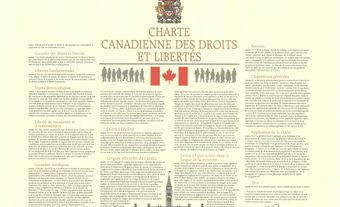The Charter of Rights and Freedoms is an important part of Canada’s Constitution. Among other things, constitutions outline the rules and laws of a country. They also outline the kind of government a country has and how it should work. A right is something a person has. It is also something a person can do.
(This article is a plain-language summary of the Charter. If you are interested in reading about this topic in more depth, please see our full-length entry, Canadian Charter of Rights and Freedoms.)

History
The first document to outline the rights and freedoms of Canadians was the Canadian Bill of Rights. It was created in 1960. It was not part of the Canadian Constitution. As a result, it did not have much authority. Provinces did not have to follow the Bill of Rights. Provinces do have to abide by the Charter of Rights and Freedoms.
Prime Minister Pierre Elliott Trudeau helped to create the Charter. He wanted all Canadians to have the same rights and freedoms. The Charter became a part of Canada’s Constitution in 1982. Trudeau patriated the Constitution. Patriation means to shift control of something from one country to another. Britain controlled Canada’s Constitution before 1982.
Some Canadians were opposed to the Charter. They worried that the meaning of “rights” and “freedoms” might be changed by judges and lawyers. René Lévesque, the premier of Quebec, was against the Constitution and the Charter. He worried that Quebec would lose much power and control. Also, Quebec already had its own Charter of Human Rights and Freedoms. Many other premiers were worried. But they sided with Trudeau after he agreed that the provinces would not have to abide by all of the Charter. They have the authority not to abide by a section of the Charter for five years. This is called the “notwithstanding clause.” It is section 33 of the Charter.
Another reason the provinces agreed to the Charter was that Trudeau created an amending formula. To amend something means to change it. The Charter can be changed if Parliament and seven provinces with at least half of Canada’s population agree to do so.
Quebec decided not to sign the Constitution Act, 1982. But it still has to abide by the Charter. The Supreme Court of Canada ruled that all provinces and territories must abide by the Charter.
The Rights and Freedoms of Canadians
Many rights and freedoms are included in the Charter:
- the right to live and seek employment anywhere in Canada
- the right to life, liberty and personal security
- the legal rights of people accused of crimes
- the rights of Indigenous peoples
- the right to equality, including gender equality
- the right to use Canada’s official languages
- the right of French or English minorities to an education in their language.
Section 2 of the Charter outlines the fundamental freedoms. (See also Human Rights.) Canadians have freedom of conscience and religion; freedom of thought, belief, opinion, and expression; freedom of peaceful assembly; and freedom of association.

 Share on Facebook
Share on Facebook Share on X
Share on X Share by Email
Share by Email Share on Google Classroom
Share on Google Classroom


